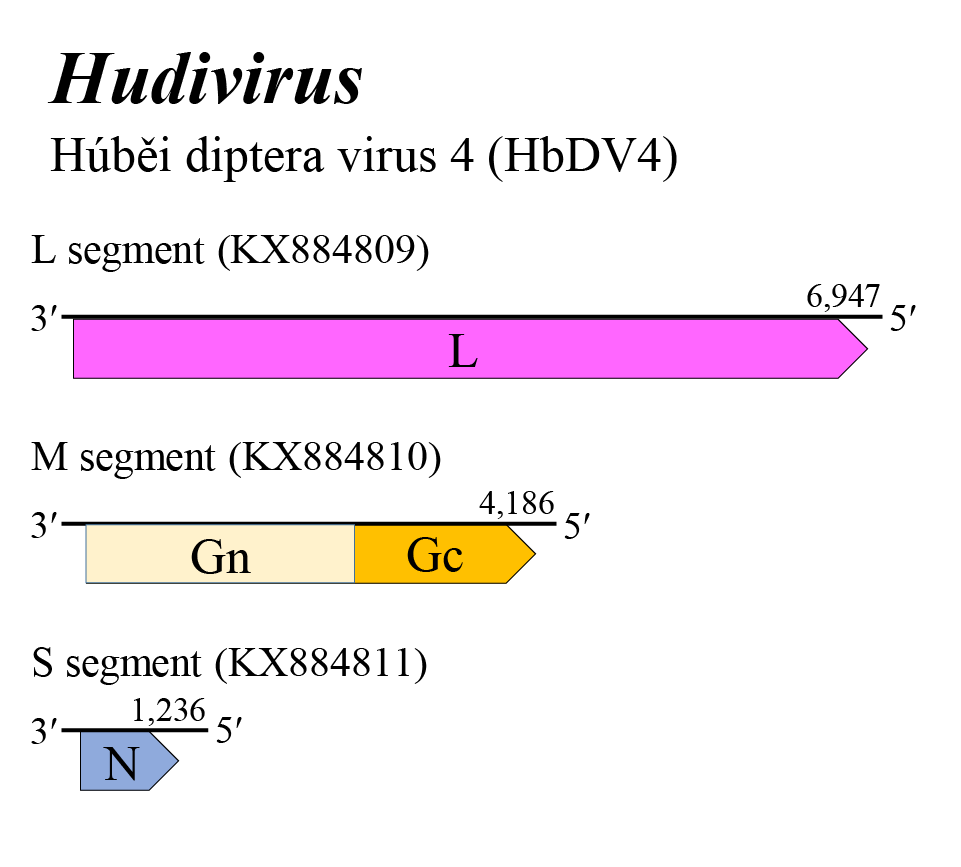Family: Phenuiviridae
Genus: Hudivirus
Distinguishing features
Húběi diptera virus 4 (HbDV4) is assigned to Hudivirus muscae, the only species in the genus. Hudivirus RNA was found by high-throughput sequencing of RNA from a fly (Diptera sp.) pool from Húběi (湖北省), China. The hudivirus genome has four genes, encoding a large protein (L), two external glycoproteins (Gn and Gc) and a nucleocapsid protein (N). Based on well-supported Maximum Likelihood or Maximum Clade Credibility trees inferred from complete L protein sequences, viruses classified in the genus Hudivirus form a monophyletic cluster clearly distinguished from other phenuivirids. There currently is no cultured hudiivirus isolate (Shi et al., 2016).
Virion
Morphology
Virion morphology is unknown. Based on the putative proteins encoded by the virus genome, the virion is probably a spherical or pleomorphic virion with an enveloped structure.
Nucleic acid and Protein
The hudivirus genome encompasses three segments of negative-sense RNA, namely L (6.9 kb), M (4.2 kb) and S (1.2 kb). Analysis of the terminal sequences has yet to be completed. All three genomic RNAs contain untranslated regions flanking a single ORF which, based on comparisons with other negative-sense RNA viruses, is predicted to be contained in the virus-complementary strand. In silico analysis of hudivirus putative ORF sequences suggests the hudivirus genome encodes three structural proteins: L with a predicted molecular mass of 255 kDa, a glycoprotein precursor (GP) of 140 kDa and N of 31 kDa, these proteins all sharing sequence homology and/or structural characteristics with the cognate proteins of other phenuivirids (Table 3 Phenuiviridae) (Shi et al., 2016).
Genome organization and replication
Hudivirus genome arrangement is similar to that of beidiviruses, citriciviruses, goukoviruses, hudoviruses, phasiviruses, pidchoviruess and tanzaviruses (Figure 1 Hudivirus). The L, M, and S segments putatively encode L, a glycoprotein precursor (comprising Gn and Gc), and N, respectively. The Gn and Gc glycoproteins of 84 kDa and 56 kDa were earlier referred to as G1 and G2 based on apparent size following gel electrophoresis. The hudivirus genome does not encode either of the non-structural proteins NSs or NSm. Details of virus replication are unknown (Shi et al., 2016).
 |
| Figure 1 Hudivirus. Genome organization of a hudivirus. Coloured boxes depict ORFs that encode N, nucleocapsid protein; Gn and Gc, external glycoproteins; and L, large protein. |
Biology
Hudiviruses have been detected in a pooled sample of flies from China (Shi et al., 2016).
Species demarcation criteria
Not defined as the genus currently includes only a single species.
Related, unclassified viruses
| Virus name | Accession number | Virus abbreviation |
| Santiago bunya-like virus | L: MT129681 | SaBLV |
Virus names and virus abbreviations are not official ICTV designations.

